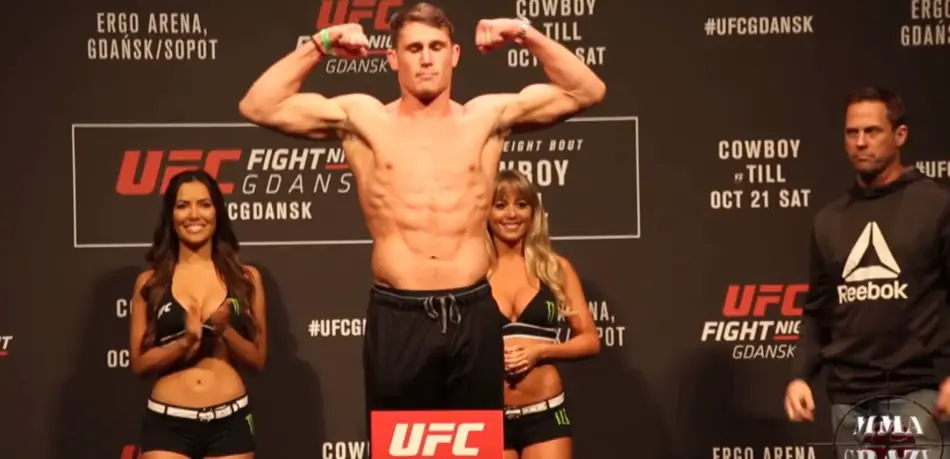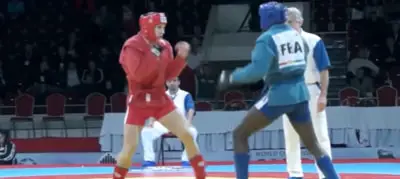
MMA fighters go through hard weight cuts the week before the fight night. But you are probably wondering how much weight they exactly cut? UFC did a study which they released where they measured the difference between fighters’ weight at weigh-ins and on fight night. The study includes 4 UFC events and more than 90 fighters. Here are the results:
What is the average weight MMAfFighters cut? On average male fighters cut 15.8 lbs (7.2 kg) while female fighters cut 12.8 lbs (5.8 kg). The average percentage of their overall weight which they cut is 10.3% for men and 10% for women.
Here is the data by weight classes:
| WEIGHT DIVISION | AVERAGE WEIGHT INCREASE (lbs) | AVERAGE PERCENTAGE REGAINED |
| Strawweight | 11.0 | 9.5% |
| Flyweight | 18.0 | 14.4% |
| Womens Flyweight | 15.6 | 12.4% |
| Bantamweight | 15.8 | 11.6% |
| Womens Bantamweight | 15.1 | 11.2% |
| Featherweight | 19.1 | 13.1% |
| Womens Featherweight | 12.6 | 8.7% |
| Lightweight | 11.7 | 7.5% |
| Welterweight | 12.6 | 7.4% |
| Middleweight | 18.7 | 10.1% |
| Light Heavyweight | 15.9 | 7.8% |
| Heavyweight | 4.3 | 1.8% |
By divisions, men Flyweight and Featherweight gain the most weight.
The fighter that gained the most amount of weight in lbs is the middleweight Paulo Costa – 27.8 lbs (12.6 kg). He weighted 186 at the weigh-ins and 213.8 on fight night.
The women bantamweight fighter Aspen Ladd gained the most weight as percentage of her overall weight. The difference between her weight at weight ins and on fight night was 17.8% (135 lbs vs 159 lbs or 24 lbs gained).
But that doesn’t mean that all fighters cut so much weight. For example heavyweights cut only 4.3 lbs on average. But other than the heavyweights, the lightweight Ryan Hall gained just 2 lbs and the bantamweight Casey Kenney just 6 lbs.
Data
It’s important to mention that the weight that fighters gained between the weigh-ins and the fight and the weight they cut aren’t exactly the same. We can’t know how much exactly weight the fighters cut because they start losing weight as they start training hard during the fight camp and few days before the fight cut just enough to make the necessary weight for their division.
However, the data we have is close to the amount they cut by dehydration in those last few days (which is basically what people refer to when saying “cutting weight”). The difference is no more than a few pounds.
Win Percentage
Expectedly the data showed that on average, the fighters who cut more weight than their opponent win more often.
Out of 47 fights, in 27 of them, the winner was the fighter who cut more weight. That means if you cut more weight than your opponent, you increase your chances of winning by 35%.
Of course there are a many other factors that determine who will win, like skill, gameplan, conditioning, focus etc. But it’s worth it to take a look at those spatistics.
Percentage vs Pounds
The exact amount of weight a fighter cut isn’t as important as the percentage of his/her overall weight. For example, if a light heavyweight fighter cuts 20 pounds that won’t be that crazy as if a flyweight does that.
That’s why there are weight classes at every 10 pounds (115; 125; 135; 145 etc) for the smaller weight classes while the gap is bigger for the heavier weight classes (155; 170; 185; 205).
The 15% Gained Weight Rule
The California State Athletic Commission (CSAC) voted a new rule that says if a fighter weight 15% more than the allowed weight for his/her division on fight night the fight will be canceled.
The idea is to discourage fighters to cut so much weight and put their health at risk. This rule is similar to the rule they voted that forced fighters to go to the weight class above if on the fight night they weight more than 10% more than than the negotiated weight at fight night.
I’m not sure if this rule came to effect, because clearly, on average. fighters weight 10% more on the fight day.
Weight cut before the fight vs Training Camp
As I mentioned fighters lose a lot of weight during the fight camp. For example, Tony Ferguson who competes at lightweight (155 lbs) says he weighs about 195 lbs when he is out of camp. Khabib Nurmagomedov (also 155er) also mentioned that his walk-around weight is 190.
They can’t possibly cut 35 – 40 pounds just by dehydration. On the fight night against Dustin Poirier, Khabib was 172lbs. If he weights 190 when he is out of camp, that means he loses an additional 18 pounds during the fight camp.
He and Tony are some extreme examples but I think we can say that fighters lose about 6-7% of their walk-around weight during training camp and another 9-10% by dehydration before the weigh-ins.
The Danger of Extreme Weight Cuts
There are definitely long term consequences of cutting so much weight in a short period of time. But there are also short-term ones that we can see on the fight night.
For example, because of the dehydration, you lose the ability to take a hard punch, you are less explosive, your conginitve functions aren’t the sharpest.
The most dangerous it’s probably the decrease of the fluid between your brain and your skull that protects the brain from bashing into the skull after you get punched/kicked in the head.
This decrease is caused by the dehydration and this is the reason why fighters can’t take punches so well when they cut too much weight.
But also the severe dehydration itself can be lethal. We’ve seen that in other sports such as wrestling and boxing.
Pros and Cons of Fighting at you Natural Weight
The obvious drawbacks of not cutting weight are that you’ll be smaller than your opponent who does it. That can be a huge factor especially when it comes to grappling/wrestling where the weight and the strength are essential.
Also heavier fighters have more power in their punches and kicks.
But that doesn’t mean that fighting at your natural weight or at least not cutting much weight can’t be beneficial. You won’t be dehydrated so you can’t be knocked out easily. But also you’ll have more energy which means more cardio and more input.
For example, when the UFC lightweight Jorge Masvidal came to welterweight (170 lbs) he started finishing people with strikes like never before.
When he was asked if that’s because he has more power at this weight class, he said it’s more because of the energy. At 155 where we had to cut a lot of weight, he had to conserve his energy. But now at 170, he feels that he has way more energy for a 15-minute fight that’s why he started to throw barrages of punches and kicks and finish almost all of his opponents.
Genrally speaking, the weight disadvantage is much bigger problem for wrestlers than for strikers because in striking things like speed, precision and timing are much more important than weight, size and strength.
But strikers need to be able to wrestle too, to defend takedows that’s why they also cut a lot of weight.
One Championship
A cool thing about One Championship (Asian MMA organization) is that weight cuts there aren’t a thing. Fighters aren’t allowed to dehydrate themselves and they are tested for dehydration every week before the fight.
That way all fighters fight at their natural weight and don’t risk their health by cutting weight. If one of the fighters is more than 5% heavier than the other, they negotiate a catchweight.
How fighters cheat at Weigh-ins
Here’s a cool video in which Chan Sung Jung, (The Korean Zombie) talks about all the tricks MMA fighters use to appear lighter on the scale than they really are:



